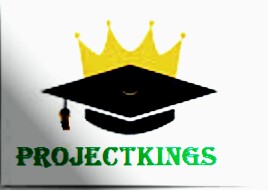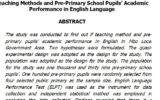Availability and Utilization of Instructional Materials in the Teaching and Learning of Biology
ABSTRACT
This work was designed to investigate the influence of instructional materials on the academic performance of Biology students. The study was carried out in Etim Ekpo Local Government Area. Two research questions were asked and one hypothesis was formulated and tested. The study adopted a survey design and 208 SSIII Biology students randomly drown from five schools form the sample of the study: Instructional materials questionnaire and 2014 Biology mock examination were used to collect data for the study. The data collected were analyzed using simple percentage and t-test. Findings revealed that two-dimensional instructional materials are available in schools but there is acute shortage of three-dimensional instructional materials, audio, audio-visual, computers and software for the teaching of Biology in the area. The study also reveals that utilization of instructional materials, influence the academic performance of students positively. It was recommended that stakeholders in education should make financial and materials provision for the acquisition of the materials needed and also monitor the utilization and the maintenance of the instructional materials.
CHAPTER ONE
INTRODUCTION
1.1 Background to the Study
A good understanding of the concept of education is derived from two approaches categorized as the broad sense and strick sense source. Education in the broad sense embraces all those experiences of the individual through which knowledge is acquired, the intellect enlightened and the will strengthen. In the strict sense, then term education is employed to designate the consciously planned and systematically applied training carried on through the various social agencies, especially the school sense. This sense implies teaching, learning, and discipline. It can only be said that education has been achieved when it has involved the active participation of the learner upon whom the whole idea of teaching and learning rests upon the source. Agwu (2005) describes education as the total process of human learning by which knowledge is imparted, faculties trained and skills developed.
One of the most important inputs to the effective teaching and learning of Biology is the use of teaching materials but in this area of economic depression, the teaching and learning of Biology at the secondary schools level is generally being carried out through taking and chalk method. Oladejo and Isola (2010) stated that one of the most important tasks of teachers is to arrange and present their lesson, topics, or learning experiences in such a way that they would have meaning to the learners both presently and in the future while striving to achieve these major objective teachers also bear in mind that all done in the name of education is expected to bring about changes in human behaviour, attitude skill, and belief. The use of teaching aids and instructional materials helps the student learn faster, comprehensively and makes the actual teaching job easier and more time-saving.
It is an indisputable fact that the role of teachers in the use of instructional resources in education is indispensable. Littrell (2009) stated that careful planning and efficient use of instructional materials make the job if a teacher was more meaningful and place his work on scientific disciplines. He added that what we see and hear simultaneously, we are apt to remember them than what we see and hear separately; since the primary means of learning, the senses are used and they reinforce each other. This is not alien to the popular saying: & hear, & forget, & see, & remembers, & do, & understand. Ojukwu (2006) observed that visual aid, in particular, can help to provide the situation which makes light the meaning the utterance used. He added that the mere use of these instructional materials does not guarantee effective communication or effective teaching.
In the science class, teaching aids are needed to supplement the teachers’ oral explanation with the students’ visible experience. This is why Abdullahi (2012) stated that scientific materials used in teaching enable the students to become actively involved intellectually, perceptually, and physically in the learning process. Fakomogbon and Adegbija (2006) observed that instructional materials help teachers to meet individual differences of the learners in the class by using aids that appeal to different senses. That instructional materials are used to supplement verbal explanation of concepts or any description so that the lesson could be real to the students. These instructional materials are categorized into audiovisual, audio and visual. These are materials that when teachers used them can appeal to students both sight and hearing.
Availability and Utilization of Instructional Materials in the Teaching and Learning of Biology
These can be electronically operated materials like Television, Radio, Film, Slide motion, computer and non-electronic ones such as chalkboards, charts, burners, models and many more. The absence of these materials in the teaching of Biology could make the class very uninteresting to students and discourage learning thereby leading to low or poor achievement. Instructional materials are very important because what students hear can easily be forgotten but what they see cannot be easily forgotten and last longer in their memory. In the contribution of Abimbola (2010) to the importance of instructional materials to the teaching and learning process, he stressed that the primary purpose of instructional materials is to make learning more effective and also facilitate it. He averred further that teachers would not be able to do much where these materials are not available.
It has been observed that human beings learn better when they hear, see, and touch so, the need arises that to help the learners, the teacher should make available learning resources to aid students to learn. Olaitan and Ali (2009) stated that the learning materials are sources from which a learner may turn and secure helpful information for the attainment of instructional objectives. They are materials designed to help the process of learning Onyejemezi (2011) expressed views on curriculum materials and approach to his job. He further stated that the learning materials should help the teacher to convey the intended message effectively and meaningfully to the learners so that the learners receive, retain and apply the experiences gained to reach overall education goals.
Eze (2009) observed that instructional material is any of device with an instructional concept or function that can be for teaching the end learning process. Therefore, it becomes pertinent that good learning models should be used in the teaching and learning in all classrooms for all subjects in every education programme if the designed result is to be achieved. This is because the best way to help learners to learn is to bring them face – to – face with the realities of the world, which education intends to introduce to them.
Nwoji (2007) observed that these learning materials contribute to the teaching-learning process in the following way, holding of students’ attention, retention of information, provision of concerned and realistic experiences, stimulation of imaginations and self-activity, clarification of abstract ideas, reinforcement of verbal message, showing of inaccessible processes materials, events, things and changes in time, speed and space, promotion of greater acquisition and longer retention of factual knowledge provision of opportunities for independent and individual learning reinforcement and enrichment of the mastery of content, prevention and correction of the misconception of abstract concepts, spatial relations and special details, and provision of high degree of interest.
Dhanarajan (2012) pointed out that learning materials must be well-designed instructional, recognized and address potential students learning behaviour and styles, take note of learner’s study circumstances and life experience, and be user friendly. Deborah (2010) added that the language of the learning materials must be simple, unambiguous, and communicative. That the materials have to be structured and sequenced in a way to cater to all types of learners. Hence this study attempts to investigate the availability and the use of instructional materials and academic performance of students in Etim Ekpo Local Government Area of Akwa Ibom State.
Availability and Utilization of Instructional Materials in the Teaching and Learning of Biology
1.2 Statement of Problem
The act of teaching is fundamentally concerned with passing ideas skills and attitudes from the teacher to the learners. In Nigeria for example, experience has shown that spoken words alone in the communication of ideas are grossly inadequate, ineffective, and inefficient in producing desired learning outcomes. Every year when results of public examinations are released, there has always been a mass failure in sciences generally and biology in particular. The reason for this could be ascribed to the fact that there are topics in biology that pose serious problems of comprehension to students. These topics cannot be taught effectively without the use of relevant instructional materials to make the learning practical and more realistic.
On the foregoing, scholars like Oliatan and Ali (2009) have emphasized the effect of instructional materials utilization on teaching and learning. According to them we learn and remember 10% of what we hear, 40% of what we discuss with others and as high as 80% of what we experience directly or practice. However, the problem that this study sought to address is how do instructional materials influence the academic performance of Biology students in public secondary schools in Etim Ekpo Local Government Area of Akwa Ibom State?
1.3 Purpose of the Study
The purpose of this study is to investigate the influence of instructional materials on the academic performance of biology students in Etim Ekpo Local Government Area. The specific purpose were:
(i) To determine the extent of availability of instructional materials in public secondary schools in Etim Ekpo Local Government Area.
(ii) To what extent do biology teachers use instructional materials in the teaching and learning of biology in public secondary schools in Etim Ekpo Local Government Area?
1.4 Significant of the Study
Results of this will be utilized by teachers, school authorities, and the government. The study is expected to create awareness to learners, the school authority, the ministry of education, and the government of Akwa Ibom State on the availability and utilization of instructional materials in schools. This will make teachers rise up to the challenge, it will also make the school authority and government to intervene, strategize and consequently supervise and monitor the classroom teachers on the use of these materials to facilitate learning in the schools.
1.5 Research Questions
The following research questions were asked to direct the study.
(i) To What extent do public secondary schools in Etim Ekpo Local Government Area are equipped with instructional materials for teaching biology?
(ii) To what extent do biology teachers in Etim Ekpo Local Government Area use the available instructional materials in the teaching of biology?
Availability and Utilization of Instructional Materials in the Teaching and Learning of Biology


